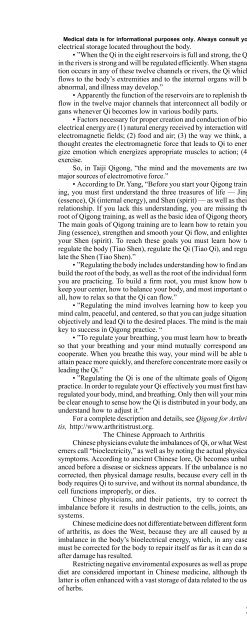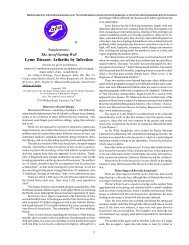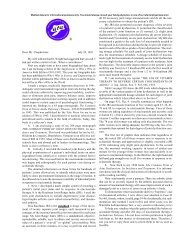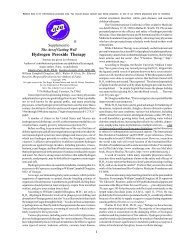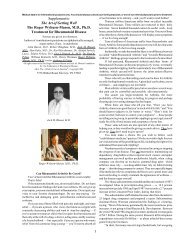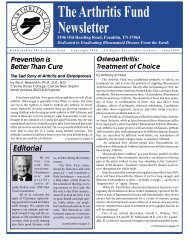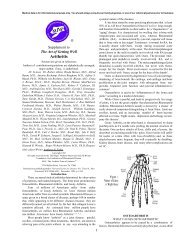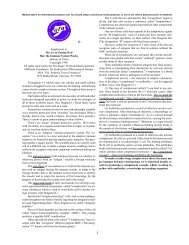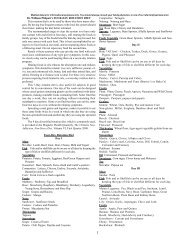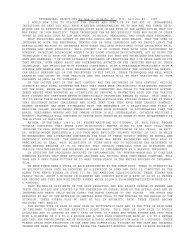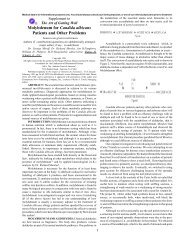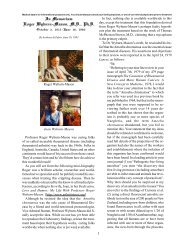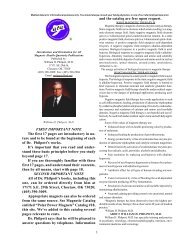Soft Tissue Arthritis Supplement - PDF - Arthritis Trust of America
Soft Tissue Arthritis Supplement - PDF - Arthritis Trust of America
Soft Tissue Arthritis Supplement - PDF - Arthritis Trust of America
Create successful ePaper yourself
Turn your PDF publications into a flip-book with our unique Google optimized e-Paper software.
Medical data is for informational purposes only. Always consult your family physician, or one <strong>of</strong> our referral physicians prior to treatment.<br />
electrical storage located throughout the body.<br />
• ”When the Qi in the eight reservoirs is full and strong, the Qi<br />
in the rivers is strong and will be regulated efficiently. When stagnation<br />
occurs in any <strong>of</strong> these twelve channels or rivers, the Qi which<br />
flows to the body’s extremities and to the internal organs will be<br />
abnormal, and illness may develop.”<br />
• Apparently the function <strong>of</strong> the reservoirs are to replenish the<br />
flow in the twelve major channels that interconnect all bodily organs<br />
whenever Qi becomes low in various bodily parts.<br />
• Factors necessary for proper creation and conduction <strong>of</strong> bioelectrical<br />
energy are (1) natural energy received by interaction with<br />
electromagnetic fields; (2) food and air; (3) the way we think, as<br />
thought creates the electromagnetic force that leads to Qi to energize<br />
emotion which energizes appropriate muscles to action; (4)<br />
exercise.<br />
So, in Taiji Qigong, “the mind and the movements are two<br />
major sources <strong>of</strong> electromotive force.”<br />
• According to Dr. Yang, “Before you start your Qigong training,<br />
you must first understand the three treasures <strong>of</strong> life — Jing<br />
(essence), Qi (internal energy), and Shen (spirit) — as well as their<br />
relationship. If you lack this understanding, you are missing the<br />
root <strong>of</strong> Qigong training, as well as the basic idea <strong>of</strong> Qigong theory.<br />
The main goals <strong>of</strong> Qigong training are to learn how to retain your<br />
Jing (essence), strengthen and smooth your Qi flow, and enlighten<br />
your Shen (spirit). To reach these goals you must learn how to<br />
regulate the body (Tiao Shen), regulate the Qi (Tiao Qi), and regulate<br />
the Shen (Tiao Shen).”<br />
• ”Regulating the body includes understanding how to find and<br />
build the root <strong>of</strong> the body, as well as the root <strong>of</strong> the individual forms<br />
you are practicing. To build a firm root, you must know how to<br />
keep your center, how to balance your body, and most important <strong>of</strong><br />
all, how to relax so that the Qi can flow.”<br />
• ”Regulating the mind involves learning how to keep your<br />
mind calm, peaceful, and centered, so that you can judge situations<br />
objectively and lead Qi to the desired places. The mind is the main<br />
key to success in Qigong practice. “<br />
• ”To regulate your breathing, you must learn how to breathe<br />
so that your breathing and your mind mutually correspond and<br />
cooperate. When you breathe this way, your mind will be able to<br />
attain peace more quickly, and therefore concentrate more easily on<br />
leading the Qi.”<br />
• ”Regulating the Qi is one <strong>of</strong> the ultimate goals <strong>of</strong> Qigong<br />
practice. In order to regulate your Qi effectively you must first have<br />
regulated your body, mind, and breathing. Only then will your mind<br />
be clear enough to sense how the Qi is distributed in your body, and<br />
understand how to adjust it.”<br />
For a complete description and details, see Qigong for <strong>Arthritis</strong>,<br />
http://www.arthritistrust.org.<br />
The Chinese Approach to <strong>Arthritis</strong><br />
Chinese physicians evalute the imbalances <strong>of</strong> Qi, or what Westerners<br />
call “bioelectricity,” as well as by noting the actual physical<br />
symptoms. According to ancient Chinese lore, Qi becomes unbalanced<br />
before a disease or sickness appears. If the unbalance is not<br />
corrected, then physical damage results, because every cell in the<br />
body requires Qi to survive, and without its normal abundance, the<br />
cell functions improperly, or dies.<br />
Chinese physicians, and their patients, try to correct the<br />
imbalance before it results in destruction to the cells, joints, and<br />
systems.<br />
Chinese medicine does not differentiate between different forms<br />
<strong>of</strong> arthritis, as does the West, because they are all caused by an<br />
imbalance in the body’s bioelectrical energy, which, in any case,<br />
must be corrected for the body to repair itself as far as it can do so<br />
after damage has resulted.<br />
Restricting negative enviromental exposures as well as proper<br />
diet are considered important in Chinese medicine, although the<br />
latter is <strong>of</strong>ten enhanced with a vast storage <strong>of</strong> data related to the use<br />
<strong>of</strong> herbs.<br />
23<br />
Dr. Yang lists these ways as means for treating arthritis:<br />
• Prevent arthritis from happening, or from getting worse.<br />
• Massage, when properly done, can improve Qi circulation in<br />
the joint area.<br />
• Acupuncture can temporarily halt pain and also increase Qi<br />
circulation. Western physicians have also shown that it can<br />
strengthen the immune system.<br />
• Herbal remedies are used to alleviate pain, increase Qi circulation,<br />
help healing <strong>of</strong> injuries, and speed up healing.<br />
• Cavity Press (Dian Xue) is a “method <strong>of</strong> using the fingertips<br />
(especially the thumb tip) to press acupuncture cavities and certain<br />
other points (pressure points) on the body in order to manipulate<br />
the Qi circulation.”<br />
While it may take years to learn to use acupuncture properly,<br />
according to Dr. Jang Jwing-Ming, Cavity Press can be learned<br />
quickly and requires no equipment.<br />
“In Cavity Press, stagnant Qi deep in the joint is led to the<br />
surface. This improves the Qi circulation in the joint area, and<br />
considerably reduces the pain. The use <strong>of</strong> cavity press to speed up<br />
the healing <strong>of</strong> injured joints is very common in the Chinese martial<br />
arts.”<br />
• Qigong exercises for arthritis have the main purpose <strong>of</strong> rebuilding<br />
the strength <strong>of</strong> the joint by improving Qi circulation. As<br />
long as there is a proper supply <strong>of</strong> Qi at the joints, they can be<br />
repaired and, in some cases, even be rebuilt.<br />
“Practicing Qigong can not only heal arthritis or joint injury<br />
and rebuild the joint, it is also known to be very effective in strengthening<br />
the internal organs. Many illnesses, including some forms <strong>of</strong><br />
arthritis, stem from abnormally functioning internal organs.”<br />
According to Roger Jahnke, O.M.D., 39 “Qigong accelerates<br />
oxygen distribution in the body at a time when your muscles are not<br />
rapidly using it as they would be in aerobics or running. This enables<br />
cells to begin their repair work.<br />
“Second, there is a tremendous benefit to the immune system.<br />
Qigong shifts the body into a state where the autonomic nervous<br />
system moves toward the parasympathetic-sympathetic balance,<br />
which then supports and enhances the activities <strong>of</strong> the immune<br />
system.<br />
“Third, Qigong helps to turn on the body’s ‘garbage disposal<br />
system’ known as the lymph, thereby eliminating toxins, metabolites,<br />
and pathogenic factors from the tissues.” (See “Lymph Detoxification”<br />
and “Lymph Drainage,” http://www.arthritistrust.org.”<br />
With a healthy flow <strong>of</strong> Qi circulation, internal organs will be<br />
healthy, the immune system will be strengthened, and the spirit will<br />
be at peace.<br />
Reconstructive Therapy<br />
Reconstructive Therapy can be very successful in alleviating,<br />
or completely solving various forms <strong>of</strong> Bursitis or Fibromyalgia.<br />
Whenever tendons or ligaments are stretched or torn, the body<br />
compensates by producing stress or pain in another part <strong>of</strong> the<br />
body. Reconstructive therapy tightens up tendons and ligaments,<br />
thus eliminating pain. (See Pain, Pain Go Away! Prolo Your Pain<br />
Away, and “Sclerotherapy, Proliferative Therapy, Reconstructive<br />
Therapy: Treatment <strong>of</strong> First Choice for Osteoarthritis and for Other<br />
Arthritic-like Pain,” http://www.arthritistrust.org.)<br />
The Case <strong>of</strong> Alberta Hardwick<br />
Alberta Hardwick, 42-years-<strong>of</strong>-age, a pharmacist, had diffuse<br />
body aches, and even required a neck brace to get through the day.<br />
When Ross A. Hauser, M.D., 52 Caring Medical & Rehabilitation<br />
Services <strong>of</strong> Oak Park, Illinois conducted a physical examination, he<br />
found “exquisitely tender” Fibromyalgia points over the 18 characteristic<br />
positions. Other symptoms included numbness, stomach<br />
pain, stiffness, pain in the arms, temporomandibular joint (TMJ:<br />
jaw/hinge joint), legs, lower back, neck, shoulders, and shoulder<br />
blades, and Alberta also suffered from non-restful sleep and difficulty<br />
in sleeping.<br />
Alberta had been hospitalized for pain, and also had had sev-


